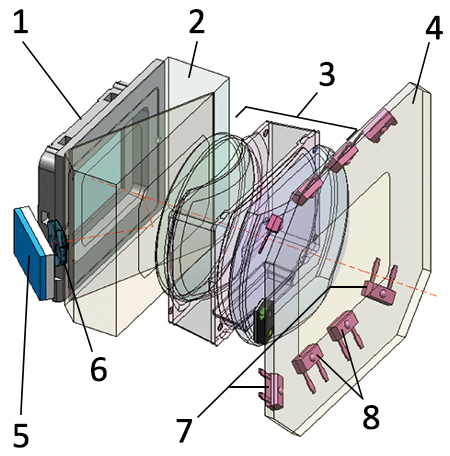The EOS R3 features Eye Control AF, which lets you set or shift the AF point to what you’re looking at by detecting your line of sight. How is this feat accomplished? Read on to learn about the system’s architecture! (Reported by: Kazuo Nakahara, Digital Camera Magazine)

Answer: It senses eyeball movements by detecting light that reflects off your cornea
Within the EOS R3’s electronic viewfinder, there are eight infrared LED lamps and a 7.56-megapixel line-of-sight detection sensor. The infrared LED lamps shine infrared lights onto your eye. The light that reflects off your cornea is picked up by the line-of-sight sensor, which uses the information to calculate where you are looking. Working together, they make high precision AF control possible with Eye Control AF.
Inside the EOS R3’s viewfinder

1. OLED panel for the EVF
2. Dichroic prism for line-of-sight detection
3. Eyepiece lens
4. Eyepiece window
5. Line-of-sight detection sensor
6. Line-of-sight detection lens
7. Infrared LED lights for line-of-sight detection (when wearing glasses)
8. Infrared LED lights for line-of-sight detection (bare eyes)
The dichroic prism (2.) in the EOS R3’s EVF reflects light waves of specific lengths, facilitating line-of-sight detection. The use of glass-moulded aspherical lenses and other technologies ensure that your view through the EVF remains unaffected.

Know this: Situations that may hinder Eye Control AF function
The Eye Control AF system can detect your line-of-sight even when it’s dark, or when you wear glasses. However, there may be issues if you wear sunglasses or hard or coloured contact lenses.

When the subject is all the way in the corner of the frame, it is quicker and more convenient to be able to move the AF point to it simply by looking at it! However, do note that it might not be the best AF method for certain scenes or shooting styles, such as when you need to look at all corners of the image to check your composition.
Fun fact: The EOS R3 isn’t the first camera to feature Eye Control AF
Eye Control AF first debuted on the EOS 5, a film camera released in 1992. The method of eye movement detection used on the EOS R3 is based on the same principles on the EOS-3, another film camera released in 1998. However, due to the many challenges in the technology available at that time, it wasn’t implemented in later cameras.
Major technological improvements in recent years provided the opportunity to refine and improve on earlier versions of Eye Control AF technology, culminating in its reintroduction on the EOS R3.
Also see:
Vol.4 Revamped eye control AF that transcends the ages – Focusing on what you’re followin
Unravelling the AF Features on the EOS R3
About the Author
A monthly magazine that believes that enjoyment of photography will increase the more one learns about camera functions. It delivers news on the latest cameras and features and regularly introduces various photography techniques.
Published by Impress Corporation
Born in Hokkaido in 1982, Nakahara turned to photography after working at a chemical manufacturing company. He majored in photography at the Vantan Design Institute and is a lecturer for photography workshops and seminars, in addition to working in commercial photography. He is also a representative of the photography information website studio9.































.jpg)


